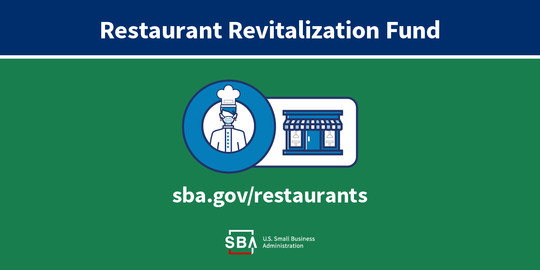The U.S. Small Business Administration (SBA) is taking applications for the Restaurant Revitalization Fund (sba.gov/restaurantes en Español):
The $28 billion relief measure made possible by the American Rescue Plan will provide restaurants with funding equal to their pandemic-related revenue loss up to $10 million per business and no more than $5 million per physical location. Recipients are not required to repay the funding as long as funds are used for eligible uses no later than March 11, 2023.
Businesses are encouraged to apply as soon as possible. The deadline is now 7 p.m. Central May 24.
What you need to know
- For many businesses (those opened before 2019), you can calculate how much you qualify for by using this formula: 2019 gross receipts minus 2020 gross receipts minus PPP loan amounts.
- Businesses that opened during 2019, during 2020 or have yet to open but incurred expenses in 2020 and 2021 are eligible to apply. They all have different calculations, and the basic breakdowns are on the RRF page. You can also read the fine print at the back of the application and the 11 things that define an “eligible expense.”
- Funds may be used for specific expenses, including:
- Business payroll costs (including sick leave)
- Payments on any business mortgage obligation
- Business rent payments (note: this does not include prepayment of rent)
- Business debt service (both principal and interest; note: this does not include any prepayment of principal or interest)
- Business utility payments
- Business maintenance expenses
- Construction of outdoor seating
- Business supplies (including protective equipment and cleaning materials)
- Business food and beverage expenses (including raw materials)
- Covered supplier costs
- Business operating expenses
- Brewpubs, tasting rooms, taprooms, breweries, wineries, distilleries, bakeries and inns are all eligible but must meet certain levels of proof to qualify. Refer to the RRF page for the percentages.
- The covered period to use these funds for eligible expenses is 2/15/2020 to 3/11/2023 or when the business permanently closes. Money not used by the end of this period must be returned.
- Businesses cannot be permanently closed and then reopen using these funds.
How you can prepare
- Review the sample application, program guide and cross-program eligibility chart on SBA COVID-19 relief options. And get a first look at the application portal in this hourlong SBA video.
- Make sure you have your 2020 taxes finished. While it is not required, it is helpful in proving 2019 and 2020 gross revenues. You have your choice on how to prove it:
- For corporations: Form 1120(s), bank statements, income statements or P&L, or Point of Sale reports along with 1099K
- For sole proprietorships or LLCs: 1040 Schedule C or F, bank statements, income statements or P&L or Point of Sale reports and 1099Ks
- For partnerships: Form 1065 (including K-1s), bank statements, income statements or P&L or Point of Sale reports and 1099Ks
- Watch a recorded webinar:
- SBA Administrator Guzman’s Special Briefing on RRF.
- If you have questions or need general restaurant operations assistance, reach out to me, Jason Schleip, the Wisconsin Restaurant Initiative consultant. The SBA also will have support for applications at and 844-279-889.
How to apply and stay up to date
- You can apply through SBA-recognized Point of Sale Restaurant Partners or directly via SBA portal. Registration with SAM.gov is not required. DUNS or CAGE identifiers are also not required.
- For the first 21 days, the SBA will accept applications from all eligible applicants but only process and fund those from three priority groups — small businesses majority-owned by women, veterans and socially / economically disadvantaged individuals. (Note: A National Guard member is not a veteran unless they’ve either served active duty or served 20 years in the Guard.)
- You can sign up for alerts and check www.wwwtest.wisconsinsbdc.org/covid-19/#RRF for the latest information.
